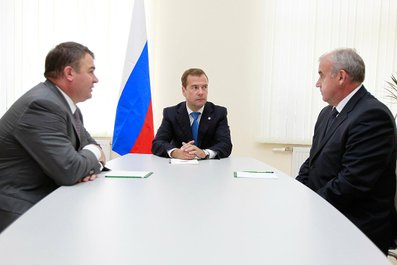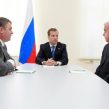
Russian Automated Command and Control: Recasting the Network
Publication: Eurasia Daily Monitor Volume: 8 Issue: 211
By:

According to Sergei Konovalov, a Moscow-based defense journalist, for the first time since the reform of the Russian Armed forces was initiated in October 2008, its central theme has been questioned by a general that was once considered to be very close to the process – Lieutenant-General Sergei Skokov. The critique itself relates to the Unified System for Command and Control at the Tactical Level (Yedinaya Avtomatizirovannaya Sistema Upravleniya Takticheskim Zvenom – YeSU TZ), which was recently tested in the 5th Motorized Rifle Brigade (MRB), Alabino. If the critique attributed to Skokov accurately reflects his views, it may be the clearest evidence yet that not only is the reform in chaos, but the top brass lack a clear understanding of what the process is actually about (https://www.ng.ru/nvo/2011-10-20/100_brigada.html).
Skokov is important for several reasons. He gained a reputation for being among the more progressive senior officers and was ardently committed to the modernization and transformation of the Armed Forces. Skokov, as the chief of the Ground Forces’ main staff was also tasked with overseeing the development and testing of the YeSU TZ, and understood how critical this was to the reform agenda and introducing network-centric capabilities. However, in the summer of 2011, Skokov resigned from the Armed Forces, prompting speculation about why he chose to depart at such a key moment. Skokov was therefore well placed to appreciate the nature of the problems associated with introducing the YeSU TZ. To date, the design issues that have resulted in delaying the appearance of the automated command and control (C2) system have been mainly linked to the software – particularly the graphic display and the overly complicated clusters of icons, rendering the system non-user friendly. This stemmed from the weakness of the defense industry and the difficulty in coordinating the design of the new C2 with the actual needs of the military. Nevertheless, Skokov apparently blames the military’s leadership. The problems with the system are not primarily linked, in his view, to the developers but the approach adopted by the defense ministry: the main efforts focus on the functional duties of the command posts during combat operations. However, Skokov believes that the top brass have failed to link computer algorithms to the contemporary situation – they are trying to adopt network-centric approaches while adhering to old methods. This early effort to develop network-centric capabilities is failing due to the planning focusing on its use in combat operations at the expense of the preparation phase. Worse still, the general believes that the top brass are currently adding two spheres to the traditional three spheres of combat: (air, land, and sea) information and space (https://www.ng.ru/nvo/2011-10-20/100_brigada.html).
This sense of confusion and chaotic planning in the course of trying to transform and modernize the Armed Forces has emerged throughout the reporting on the state armaments program to 2020, which envisages increasing the share of modern or new weapons and equipment in the table of organization and equipment to 70 percent. The flaws in this process are numerous, and leading officials are becoming more open about the potential for large-scale correction at a later stage. What the defense ministry ignores is that to conduct the modernization successfully, even if the defense industry proved to be capable of meeting such a massive challenge would first demand working out network-centric doctrine, operational planning, as well as its tactics, while cooperating closely with manufacturers in order to match the procurement requirements to the new approach to warfare. Underlying the reported weaknesses in the rearmament plans are much deeper issues, and Konovalov’s interlocutors are hinting at some, though by no means all of these problems. On October 11, the First Deputy Defense Minister Aleksandr Sukhorukov gave an extensive press conference outlining the nature of the modernization planning. Sukhorukov was realistic in his assessment of the defense industry and the myriad of issues mitigating the success of the rearmament agenda (Interfax, October 11).
Sukhorukov explained that action had been taken to address the complex nature of financial transfers linked to defense contracts, but he admitted that the price formation on the most expensive and sophisticated models of armaments remains a serious problem. In fact, the key issue is the extreme difficulty encountered in any attempt to obtain price “transparency.” The simplified process, which he then outlined, offered little hope for the speedy resolution of this “serious problem.” Sukhorukov added that he is “quite familiar” with the numerous contract violations committed by defense industry companies, in terms of meeting deadlines, submitting undocumented expense claims, or delivering inferior quality products which result in complaints by troops. The volume of complaints is continuing to grow. In 2010, the number of complaints to the defense ministry from the Armed Forces reached 1,764, which was an increase year-on-year of 20 percent. During the first half of 2011, the number of complaints rose by 10 percent year-on-year, which Sukhorukov explained denotes the decline in the quality of manufactured products (https://vpk-news.ru/articles/8250).
The decision by the defense ministry to classify as secret the latest testing of the automated C2 in the 5th MRB, suggests perhaps good reason to keep the problems away from prying eyes. One Russian defense expert, Mikhail Rastopshin, speculated that the YeSU TZ has low survivability, which if correct, would certainly be a major flaw. Given that those involved in the design of the Bulava (Sea Launched Ballistic Missile) admitted the key shortcoming was “systems integration” it is not entirely implausible that a potentially serious failing has been discovered in the automated C2. The classified exercise to test the automated C2 system was held under the leadership of Major-General Sergei Yudin, the Commander of the 20th Combined-Arms Army, and observed by representatives from the defense ministry and defense industry. The Chief Designer of the YeSU TZ, Vadim Potapov expressed confidence that the new system will be finally accepted before the end of the year, paving the way for its introduction. The testing, according to Potapov, involved 1,700 pieces of equipment, though he offered no comment on any problems identified during the exercise (https://www.ng.ru/nvo/2011-10-20/100_brigada.html).
The nature of Skokov’s critique of what is undoubtedly a fundamental element of the modernization program is unsurprising given the mindset of the top brass steeped in traditional methods of planning and conducting combat operations. But they may well grossly underestimate the sheer scale of the challenge ahead as they wander down a network-centric path that is far from clearly worked out.




